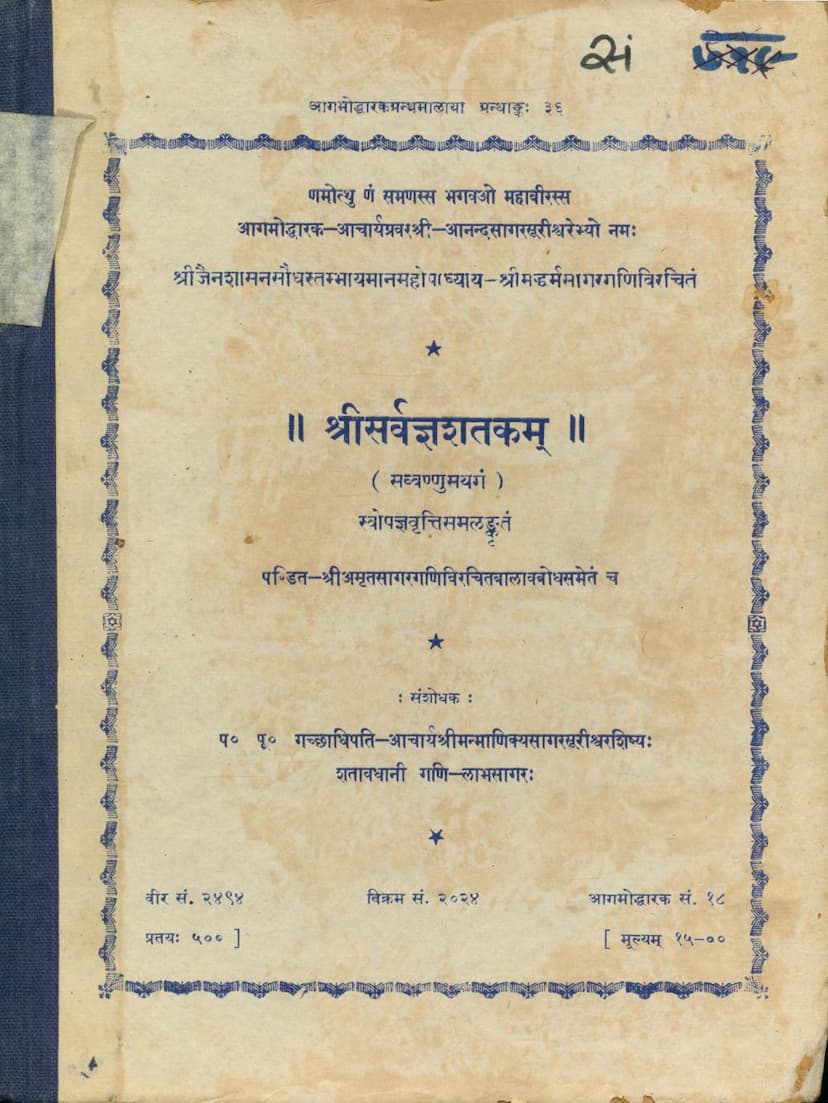Sarvagnashatakam
Added to library: September 2, 2025

Summary
Here's a comprehensive summary of the Jain text "Sarvagnashatakam" by Labhsagar, based on the provided pages:
Title: Sarvagnashatakam (also referred to as Sarvajna Shataka or Sarvagnashatak)
Author: Labhsagar (as the compiler/editor)
Original Author of Sarvagnashatak: Mahamahopadhyaya Shrimaddharma Sagar Ganivar
Commentary (Vritti): Swopadnyavritti (commentary by the original author, Mahamahopadhyaya Shrimaddharma Sagar Ganivar)
Balavabodha (Simplified Explanation): Pandit Shrimad Amrut Sagar Gani Virachit Balavabodha
Publisher: Agamoddharak Granthmala
Publication Details:
- Ank (Serial Number): 36
- Veer Samvat: 2494
- Vikram Samvat: 2024
- Agamoddharak Samvat: 18
- Price: 15-00
- Copies Printed: 500
Context and Significance:
The book is presented as the 36th gem published by the Agamoddharak Granthmala, an institution established in Visamvat 2010 (1953 CE) with the blessings of Acharya Shriman Manikya Sagar Surishwarji Maharaj and the inspiration of Muniratna Suryoday Sagarji Maharaj. The Granthmala has published 35 works in 14 years.
The "Sarvagnashatakam" is a significant work that includes the original text (Mul), the author's own commentary (Vritti), and a simplified explanation (Balavabodha). The text itself is a critique and explanation of various philosophical and practical points within Jainism, particularly addressing disputes and clarifying doctrines prevalent at the time of its original author, Mahamahopadhyaya Shrimaddharma Sagar Ganivar.
Key Content and Themes:
The provided pages offer a glimpse into the content and the intellectual context surrounding the publication of this work. The text appears to be a commentary on a work that discusses the nature of the omniscient (Sarvajna), differentiating between the state of a Chhadmastha (one with residual karmic matter) and a Kevali (one who has attained omniscience).
The book delves into various complex Jain philosophical concepts, including:
- The nature of omniscience (Sarvajna): The text aims to explain and reconcile different views on the qualities and perceptions of the omniscient being.
- Distinguishing between Chhadmastha and Kevali: The text elaborates on the differences, particularly focusing on the signs (lingas) that indicate these states. It highlights that while a Chhadmastha may have certain limitations, a Kevali is free from these, including the ability to cause harm or error.
- The concept of "Apavada" (Exception) and "Apavada Kalpa" (Exceptional Exception): The text discusses these subtle points, especially in relation to Jain conduct and how they apply to monks and omniscient beings. It clarifies that actions that might seem problematic are understood within the specific context of their spiritual stage and the omniscient’s perfect knowledge.
- Resolving doctrinal differences: The "Anukha" (Introduction) and "Uposha" (Preface) sections emphasize that the "Sarvashatak" text provides resolutions to various differences of opinion that existed in the past, based on scriptural principles and evidence.
- The author's lineage and legacy: The introduction highlights the scholarly and influential life of Mahamahopadhyaya Shrimaddharma Sagar Ganivar, a prominent figure in the Tapagachchha tradition. His intellectual prowess and role in debating and defending Jain principles are emphasized. The text also mentions his numerous other works.
- Debates and Scholarly Rigor: The text touches upon the historical context of Jain scholarship, mentioning debates and the need for accurate interpretation of scriptures. The Balavabodha by Amrut Sagar Gani is noted for retaining the ancient Gujarati language for better understanding of the original text.
- Specific Philosophical Points: The index (Page 22 onwards) lists numerous topics, including:
- The signs of a Chhadmastha and a Kevali.
- The impossibility of the Kevali incurring karma or violating the vows.
- The concept of apology (Apavada) and its exceptions.
- The definition of Himsa (violence) and its different forms.
- The flaws in other philosophical views (Kumat) and their refutation.
- The importance of right knowledge, perception, and conduct (Samyakgyan, Samyagdarshan, Samyakcharitra) as the path to liberation.
- Detailed discussions on specific instances and interpretations of Jain philosophy, such as the permissibility of crossing rivers or the nature of karma.
- The refutation of erroneous beliefs and the exposition of correct Jain tenets.
The Role of the Compiler (Labhsagar):
Labhsagar, identified as a "Shatavadhani" (one with a photographic memory or extraordinary power of retention), is credited with compiling and researching the work. His contribution is significant in making this ancient and profound text accessible to a wider audience with the addition of the Balavabodha.
Overall Purpose:
The "Sarvagnashatakam," through its author's commentary and the compiler's efforts, aims to provide a clear and comprehensive understanding of essential Jain doctrines, resolve philosophical queries, and uphold the authority of the Agamas. It serves as a valuable resource for Jain scholars and practitioners seeking deeper knowledge of the faith.
This summary provides an overview based on the provided metadata and initial pages. A more detailed understanding would require a complete study of the text itself.